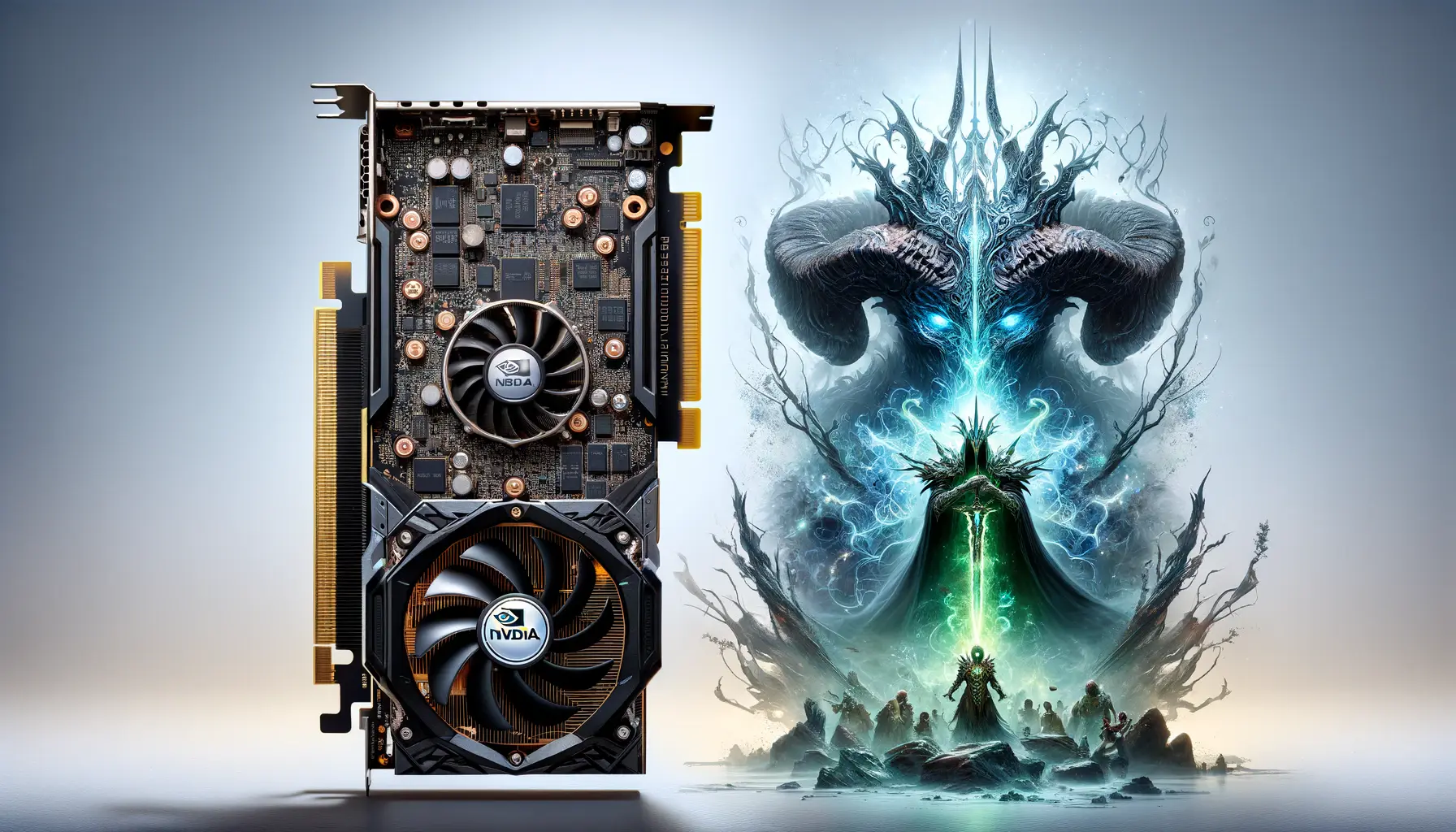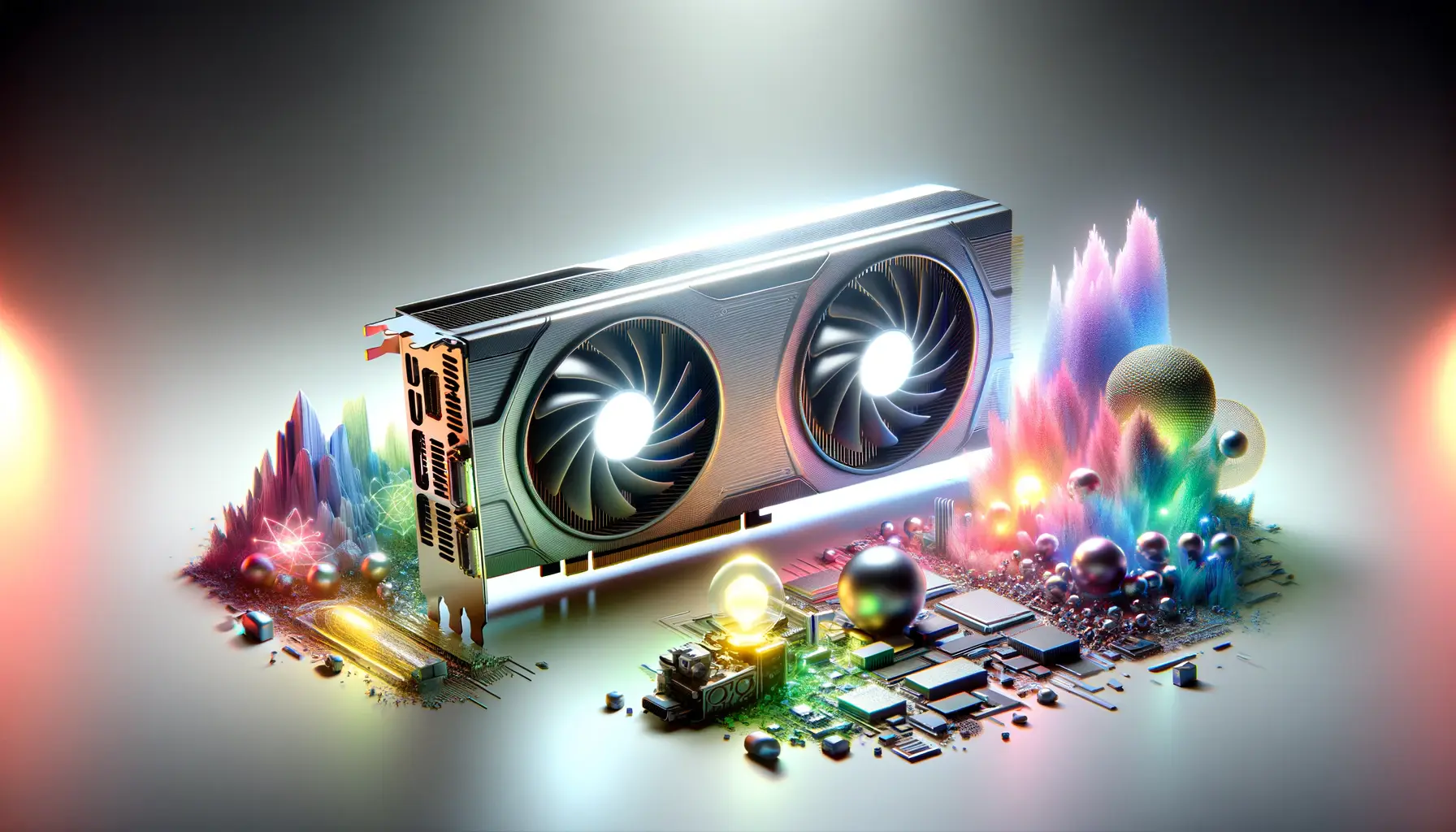The advent of NVIDIA’s DLSS 3 has marked a significant milestone in the realm of game development and graphics rendering.
This cutting-edge technology, standing for Deep Learning Super Sampling, has been designed to revolutionize the way games are played and experienced.
By leveraging artificial intelligence and machine learning, DLSS 3 enables developers to achieve higher frame rates and improved image quality without the need for extensive hardware upgrades.
The essence of DLSS 3 lies in its ability to upscale lower-resolution images in real-time, making them appear as if they were rendered in higher resolution.
For developers, DLSS 3 presents a unique set of opportunities and challenges.
The technology not only enhances the visual fidelity of games but also optimizes performance across a wide range of hardware.
However, integrating DLSS 3 into game development workflows requires a nuanced understanding of its mechanisms and best practices.
This article aims to shed light on optimization tips for developers looking to harness the power of DLSS 3, ensuring that their games not only look stunning but also run smoothly on diverse gaming setups.
- Understanding DLSS 3 and Its Impact on Game Development
- Best Practices for Implementing DLSS 3 in Game Development
- Challenges and Solutions in DLSS 3 Integration
- DLSS 3’s Role in Future Game Development
- Optimizing Game Performance with DLSS 3
- DLSS 3 and the Evolution of Gaming Aesthetics
- Collaboration and Community in the Era of DLSS 3
- Embracing the Future with DLSS 3: A Conclusion
- DLSS 3 Optimization Tips for Developers: FAQs
Understanding DLSS 3 and Its Impact on Game Development
At its core, DLSS 3 is a game-changer for the gaming industry, particularly in how it utilizes neural networks to interpolate frames and enhance overall game performance.
This technology is a leap forward from its predecessors, offering not just improved frame rates but also significantly better image quality.
For developers, this means being able to push the boundaries of visual realism without compromising on performance.
One of the key benefits of DLSS 3 is its adaptability across various hardware configurations.
This adaptability ensures that games utilizing DLSS 3 can reach a broader audience, including those with older or less powerful gaming rigs.
The technology’s deep learning algorithms analyze thousands of game frames and intelligently generate high-quality images from lower-resolution inputs, making it a potent tool for optimization.
Integrating DLSS 3 into Your Development Pipeline
Integrating DLSS 3 into a game’s development pipeline is a strategic move that can significantly enhance the game’s appeal and performance.
The process involves working closely with NVIDIA’s development tools and ensuring that the game engine is compatible with DLSS technology.
Developers must also consider the impact of DLSS 3 on game design, particularly in terms of graphical assets and rendering techniques.
It’s crucial for developers to familiarize themselves with the DLSS SDK and the various settings and options available within the technology.
Experimentation and testing are key to finding the optimal DLSS settings for each game, as different titles may benefit from different configurations.
Attention to detail in this phase can lead to substantial improvements in game performance and visual quality.
DLSS 3 offers a blend of performance optimization and visual enhancement, making it an essential tool for modern game development.
Optimizing Game Assets for DLSS 3
For DLSS 3 to effectively enhance a game’s visual output, developers must optimize their game assets accordingly.
This involves creating high-quality textures and models that can scale well with DLSS’s upscaling techniques.
Developers should aim for assets that maintain their integrity and detail when viewed at various resolutions, ensuring that the upscaling process enhances rather than detracts from the game’s visual appeal.
Moreover, considering the AI-driven nature of DLSS 3, developers can leverage the technology to experiment with more dynamic and detailed environments.
By optimizing assets for DLSS, developers can achieve more immersive game worlds that were previously unattainable due to hardware limitations.
This optimization process not only improves the gaming experience for players but also expands the creative possibilities for game designers.
Best Practices for Implementing DLSS 3 in Game Development
Implementing DLSS 3 into game development is not just about flipping a switch; it requires careful consideration and adherence to best practices to fully leverage its capabilities.
Here are some essential tips and strategies for developers aiming to integrate DLSS 3 effectively:
Testing and Validation
Thorough testing is crucial to ensure that DLSS 3 integration does not negatively impact the game’s visual fidelity or performance.
Developers should conduct extensive testing across a variety of hardware configurations to identify the optimal settings for their games.
This includes:
- Comparing performance metrics with and without DLSS enabled.
- Validating image quality to ensure that upscaling does not introduce unwanted artifacts.
- Adjusting DLSS settings based on feedback from real-world users to find a balance between performance and quality.
Dynamic Resolution Scaling
Combining DLSS 3 with dynamic resolution scaling can offer a more fluid gaming experience, especially on lower-end hardware.
This approach allows the game to adjust its rendering resolution in real-time, based on performance needs, while DLSS ensures the output remains crisp.
Developers should:
- Implement dynamic resolution scaling to maintain stable frame rates during intensive gameplay moments.
- Use DLSS to upscale the dynamically scaled resolution, ensuring high image quality even when the game’s internal resolution is lowered.
User Customization Options
Providing users with customization options for DLSS settings empowers them to tailor the gaming experience to their preferences and hardware capabilities.
This includes:
- Offering different DLSS modes (e.g., Quality, Performance, Ultra Performance) within the game’s settings menu.
- Allowing users to toggle DLSS on or off, giving them control over the trade-off between image quality and performance.
Empowering users with customization options can significantly enhance their overall gaming experience, making it a win-win for both developers and gamers.
Continuous Learning and Adaptation
DLSS technology is continuously evolving, with NVIDIA regularly releasing updates that improve performance and compatibility.
Developers should stay informed about the latest advancements in DLSS technology to ensure their games benefit from the most current optimizations.
This involves:
- Keeping the game’s DLSS implementation up to date with the latest SDK releases.
- Monitoring community feedback and performance reports to identify areas for improvement.
- Engaging with NVIDIA’s developer resources for insights and support in optimizing DLSS integration.
Challenges and Solutions in DLSS 3 Integration
While DLSS 3 offers numerous benefits, integrating it into game development is not without its challenges.
Developers may encounter various obstacles, from technical issues to balancing visual fidelity with performance.
However, with the right approach, these challenges can be effectively managed.
Managing Visual Artifacts
One common challenge with DLSS 3 is the potential for visual artifacts, such as blurring or ghosting, particularly in fast-paced scenes.
To mitigate these issues, developers should:
- Adjust DLSS sharpness settings to find the right balance that minimizes artifacts without compromising image quality.
- Implement custom post-processing effects that complement DLSS upscaling to enhance overall visual clarity.
Additionally, regular updates to the DLSS algorithm by NVIDIA often address these artifact issues, so keeping the game’s DLSS implementation up to date is crucial.
Optimizing for Varied Hardware
Ensuring that games utilizing DLSS 3 run optimally across a wide range of hardware configurations can be challenging.
Solutions include:
- Conducting extensive testing on various hardware setups to identify and address performance bottlenecks.
- Providing detailed system requirements and recommended settings to help players optimize their setup for the best experience.
Developers can also leverage NVIDIA’s developer forums and support resources for advice on optimizing DLSS for different hardware profiles.
Keeping Up with Technology Updates
The rapid pace of advancements in DLSS technology means developers need to stay informed and adapt their games to leverage new features and improvements.
Strategies for staying current include:
- Subscribing to NVIDIA developer newsletters and attending webinars or conferences focused on DLSS and AI upscaling technologies.
- Participating in developer communities where peers share insights and solutions for common DLSS integration challenges.
Embracing the evolving nature of DLSS technology can turn potential challenges into opportunities for enhancing game performance and visual quality.
Addressing Player Perceptions
Some players may have reservations about the use of AI upscaling, fearing it might detract from the game’s authenticity or introduce unwanted changes.
To address these concerns, developers can:
- Offer clear explanations within the game or on official forums about how DLSS improves performance without sacrificing visual fidelity.
- Provide side-by-side comparisons or videos demonstrating the benefits of DLSS in enhancing gameplay experience.
By educating players and showcasing the tangible benefits of DLSS 3, developers can foster a more positive perception of this technology.
DLSS 3’s Role in Future Game Development
The integration of DLSS 3 into game development is not just a trend but a glimpse into the future of gaming technology.
Its impact extends beyond immediate performance improvements, shaping how games are designed, developed, and experienced by players worldwide.
Enabling More Complex Game Environments
DLSS 3 allows developers to create more detailed and complex game environments without the fear of performance penalties.
This is achieved by:
- Reducing the computational load on GPUs, thereby allowing for the inclusion of higher-quality textures, more dynamic lighting, and more NPCs or interactive elements within the game world.
- Facilitating smoother gameplay even in graphically intensive scenes, ensuring that players’ immersion is not broken by frame rate drops.
This technological advancement opens up new possibilities for game design, enabling developers to push the boundaries of what’s possible in virtual worlds.
Improving Accessibility for a Wider Audience
By optimizing performance across a range of hardware, DLSS 3 makes high-end gaming experiences more accessible to players who do not have the latest gaming rigs.
This inclusivity is crucial for:
- Expanding the potential player base for new games, as more players can enjoy high-quality gaming experiences without needing to invest in expensive hardware upgrades.
- Ensuring that games remain playable and enjoyable for longer periods, extending their lifespan and relevance in the gaming community.
Accessibility enhancements contribute to a more vibrant and diverse gaming ecosystem, where more players can participate and share in the gaming experience.
Facilitating Real-time Ray Tracing
DLSS 3 is a key enabler of real-time ray tracing in games, a technology that significantly enhances realism through accurate lighting, shadows, and reflections.
By leveraging DLSS 3, developers can:
- Incorporate real-time ray tracing into their games without severely impacting frame rates, making these advanced graphical features more feasible for a wide range of titles.
- Experiment with new visual storytelling techniques and immersive environments that were previously too performance-intensive for real-time rendering.
The synergy between DLSS 3 and real-time ray tracing is paving the way for a new era of graphical fidelity and immersion in video games.
Promoting Sustainability in Gaming
As games become more graphically advanced, the energy consumption of gaming hardware becomes a concern.
DLSS 3 addresses this by:
- Reducing the need for constant hardware upgrades, as older systems can still run new games smoothly with DLSS enabled, leading to less electronic waste.
- Decreasing the overall power consumption of gaming sessions, as DLSS 3’s efficient upscaling allows games to run at higher settings without exerting the same level of strain on the GPU.
This move towards more energy-efficient gaming practices is an important step in reducing the environmental impact of the gaming industry.
Optimizing Game Performance with DLSS 3
DLSS 3 not only enhances the visual quality of games but also plays a crucial role in optimizing game performance.
By intelligently upscaling images, it allows games to run at higher frame rates on a wide range of hardware, making it a pivotal tool for developers aiming to maximize both the beauty and smoothness of their games.
Strategies for Maximizing Frame Rates
To fully utilize DLSS 3 for performance optimization, developers can employ several strategies:
- Implementing DLSS 3 from the early stages of game development to ensure that the game’s architecture is inherently optimized for high performance.
- Adjusting game settings and DLSS parameters based on performance benchmarks to find the perfect balance between visual fidelity and frame rate.
These strategies help in achieving a seamless gaming experience, where high frame rates contribute to more responsive and enjoyable gameplay.
Customizing DLSS Settings for Different Genres
The optimal use of DLSS 3 can vary significantly across different game genres, necessitating a tailored approach:
- For fast-paced action games, developers might prioritize performance mode to ensure the smoothest possible gameplay.
- In contrast, for narrative-driven or exploration games where visual detail is paramount, the quality mode can be emphasized to enhance the game’s visual depth without compromising performance.
This customization ensures that DLSS 3 enhances the gaming experience in a manner that aligns with the game’s core appeal and the expectations of its target audience.
Leveraging DLSS for Cross-Platform Development
As the gaming industry moves towards more cross-platform releases, DLSS 3 offers significant advantages:
- It enables developers to maintain high performance and visual quality across platforms, from PCs to next-gen consoles, by optimizing resource allocation based on the capabilities of each platform.
- DLSS 3 can help standardize the development process for multi-platform games, reducing the need for platform-specific optimizations and thus shortening development cycles.
DLSS 3 is a game-changer for cross-platform development, facilitating a unified approach to game optimization that transcends hardware limitations.
Improving Game Longevity with DLSS
The impact of DLSS 3 on game performance extends beyond initial release, contributing to the longevity of games in several ways:
- By ensuring games remain playable on a wide range of hardware, DLSS 3 helps maintain a game’s player base over time.
- Continuous updates to DLSS technology can provide older games with performance boosts, potentially revitalizing interest in legacy titles.
This aspect of DLSS 3 underscores its value not just as a tool for optimization, but as a means of sustaining and enhancing the gaming ecosystem over the long term.
DLSS 3 and the Evolution of Gaming Aesthetics
The introduction of DLSS 3 by NVIDIA has not only revolutionized game performance but also significantly influenced the evolution of gaming aesthetics.
This technology enables a new level of visual quality and detail, allowing developers to explore creative directions previously limited by hardware constraints.
Enhancing Visual Realism
DLSS 3 plays a pivotal role in enhancing the visual realism of games.
By enabling higher resolutions and smoother frame rates, it allows for:
- More detailed textures and environments, bringing game worlds to life with unprecedented clarity.
- Improved lighting and shadow effects, contributing to more immersive and dynamic game atmospheres.
These improvements in visual realism not only enhance the player’s immersion but also set new standards for graphical quality in the gaming industry.
Facilitating Artistic Experimentation
With the performance headroom provided by DLSS 3, developers have greater freedom to experiment with artistic styles and visual effects.
This opens up possibilities for:
- Innovative visual storytelling techniques, where the game’s aesthetics can play a more integral role in conveying narrative and emotion.
- Unique artistic directions, such as stylized graphics or experimental visual effects, that can distinguish a game in a crowded market.
This technological advancement encourages a more diverse range of visual expressions in games, enriching the medium’s artistic landscape.
Pushing the Boundaries of Game Design
DLSS 3’s impact extends beyond aesthetics, influencing game design itself.
With the ability to maintain high performance without sacrificing visual quality, developers can:
- Incorporate more complex game mechanics and interactions that were previously too resource-intensive.
- Design larger, more detailed game worlds that offer a richer exploration experience for players.
This shift enables a more ambitious approach to game design, where developers can fully realize their creative visions without being hindered by technical limitations.
The misconception that DLSS 3 only benefits performance is debunked by its significant contributions to the evolution of gaming aesthetics and design.
Setting New Trends in Game Development
The widespread adoption of DLSS 3 is setting new trends in game development, with a focus on achieving a balance between performance, visual quality, and creative expression.
This trend is characterized by:
- A growing emphasis on visual innovation, as developers explore the full potential of DLSS 3 to enhance the visual impact of their games.
- An increased commitment to optimizing game experiences for a wide range of hardware, making high-quality gaming more accessible to a broader audience.
As DLSS 3 continues to evolve, its influence on gaming aesthetics and design is likely to deepen, driving further innovation in the industry.
Collaboration and Community in the Era of DLSS 3
The advent of DLSS 3 technology has not only transformed game development on a technical level but also fostered a new era of collaboration and community engagement within the gaming industry.
This collaborative spirit is driven by the shared goal of pushing the boundaries of what’s possible in gaming, leveraging DLSS 3’s capabilities to create experiences that are more immersive, inclusive, and visually stunning than ever before.
Developer Collaboration and Knowledge Sharing
DLSS 3 has encouraged an environment where developers, both indie and AAA, share knowledge and techniques to overcome common challenges associated with integrating this technology.
This collaboration manifests through:
- Online forums and communities where developers post tutorials, share code snippets, and offer advice on optimizing DLSS 3 within various game engines.
- Industry conferences and webinars focused on advanced graphics technologies, where insights into successful DLSS 3 integration are shared.
Such collaborative efforts not only accelerate the adoption of DLSS 3 across the industry but also contribute to a collective advancement in game development practices.
Engaging with the Gaming Community
DLSS 3 also opens new avenues for engaging with the gaming community, inviting players to be part of the conversation around game performance and visual quality.
Developers can engage with their audience by:
- Conducting beta tests that allow players to experience DLSS 3 enhancements firsthand and provide feedback.
- Hosting Q&A sessions and developer diaries that explain the benefits of DLSS 3 and how it’s being used to improve upcoming titles.
This direct engagement not only helps in fine-tuning the implementation of DLSS 3 based on player feedback but also builds anticipation and support for the technology among the gaming community.
Fostering Innovation through Competition
The competitive landscape of the gaming industry, driven by the capabilities of DLSS 3, encourages innovation as developers strive to showcase the most impressive uses of the technology.
This competition leads to:
- Games that set new benchmarks for performance and visual quality, inspiring others in the industry to explore the limits of their creativity.
- Increased investment in R&D to discover novel ways of leveraging DLSS 3 for even greater enhancements in game design and aesthetics.
Such a competitive yet collaborative environment ensures that the gaming industry continues to evolve, with DLSS 3 acting as a catalyst for new technological and creative milestones.
The era of DLSS 3 is not just about technological advancement but also about building a more collaborative, innovative, and engaged gaming ecosystem.
Conclusion
In conclusion, DLSS 3 is reshaping the landscape of game development and the gaming community in profound ways.
By fostering collaboration among developers, engaging more deeply with players, and driving competition that fuels innovation, DLSS 3 is at the heart of a vibrant era in gaming.
As this technology continues to evolve, its impact on the industry is expected to grow, promising a future where games are not only visually breathtaking and performant but also more accessible and engaging for players around the world.
Embracing the Future with DLSS 3: A Conclusion
The journey through the intricacies of DLSS 3 and its profound impact on game development and the broader gaming community underscores a pivotal shift in the digital entertainment landscape.
As we’ve explored, DLSS 3 is not merely a technological advancement; it’s a catalyst for innovation, collaboration, and a deeper connection between developers and gamers.
This conclusion aims to weave together the insights gained, highlighting the transformative role of DLSS 3 in shaping the future of gaming.
The Harmonious Blend of Performance and Aesthetics
DLSS 3 stands at the intersection of performance optimization and aesthetic enhancement, redefining what’s possible in game design and development.
By enabling games to run smoother without sacrificing visual quality, DLSS 3 offers a harmonious blend that benefits both developers and players.
This technology allows for the creation of rich, immersive worlds that were once constrained by hardware limitations, pushing the boundaries of creativity and innovation in game aesthetics.
Strengthening the Fabric of the Gaming Community
The impact of DLSS 3 extends beyond the technical realm, fostering a vibrant community of developers and gamers.
Through forums, social media, and various platforms, knowledge sharing and collaboration have become the norm, driving the industry forward.
This communal spirit is further enriched by the active participation of gamers, whose feedback and engagement play a crucial role in refining and celebrating the advancements brought about by DLSS 3.
- Developers sharing optimization tips and success stories, inspiring others to explore the potential of DLSS 3.
- Gamers experiencing firsthand the benefits of DLSS 3, leading to a more inclusive and accessible gaming world.
- Competitions and challenges that spur innovation, showcasing the incredible capabilities of DLSS 3 in enhancing game performance and visuals.
Charting the Path Forward
As we look to the future, the role of DLSS 3 in game development and the gaming experience is poised for even greater expansion.
The continuous evolution of this technology promises not only enhancements in graphical fidelity and performance but also new opportunities for creative expression and storytelling in games.
The collaboration between NVIDIA, developers, and the gaming community is essential in harnessing the full potential of DLSS 3, ensuring that the future of gaming is bright, inclusive, and boundlessly innovative.
In conclusion, DLSS 3 is more than just a feature; it’s a foundational pillar for the next generation of gaming.
Its optimization capabilities, coupled with the aesthetic improvements it brings, mark a significant leap forward for the industry.
As developers and gamers alike embrace the possibilities opened by DLSS 3, we stand on the brink of a new era in digital entertainment—one where the limits are defined not by hardware, but by imagination.
DLSS 3 Optimization Tips for Developers: FAQs
Explore commonly asked questions about DLSS 3 and its impact on game development.
DLSS 3 uses AI to upscale images, improving game performance and visual quality by generating additional frames.
DLSS 3 is supported on NVIDIA GeForce RTX 40 Series GPUs, enhancing gaming with AI-driven frame generation.
It allows developers to achieve higher frame rates and better image quality, expanding creative possibilities.
Yes, DLSS 3 optimizes performance across various hardware, making high-quality gaming more accessible.
DLSS 3 includes frame generation, AI upscaling, and performance optimization for enhanced gaming experiences.
By utilizing NVIDIA’s SDK and tools, developers can integrate DLSS 3 for improved game performance and visuals.
Yes, integrating DLSS 3 requires compatibility with game engines, often through updates or plugins.
DLSS 3 enhances visual realism and detail, enabling developers to create more immersive and visually stunning games.














